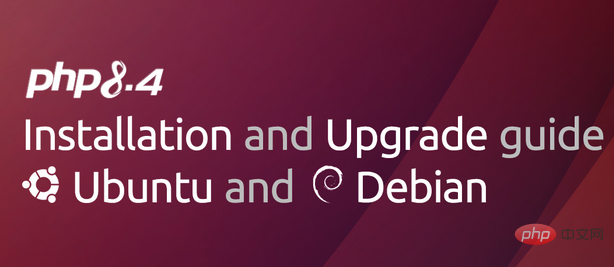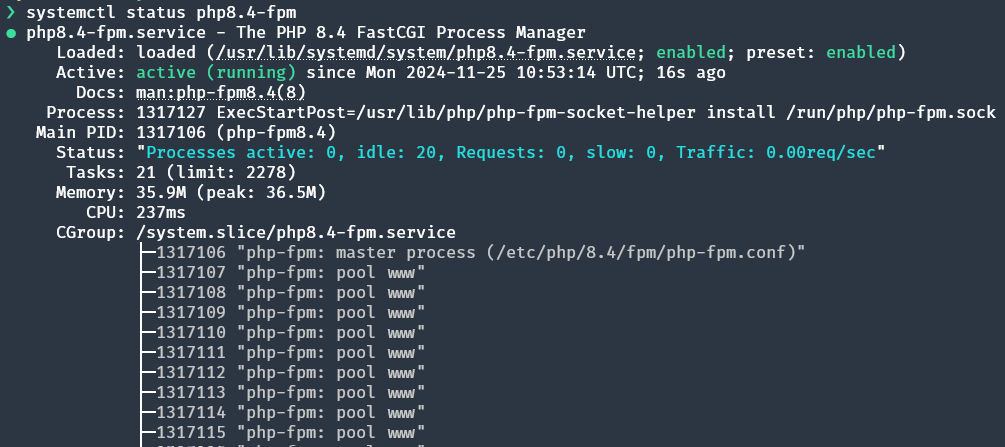PHP 8.4 Installation and Upgrade guide for Ubuntu and Debian
Dec 24, 2024 pm 04:42 PMPHP 8.4 brings several new features, security improvements, and performance improvements with healthy amounts of feature deprecations and removals.
This guide explains how to install PHP 8.4 or upgrade to PHP 8.4 on Ubuntu, Debian, or their derivatives. Although it is possible to compile PHP from source, installing it from an APT repository as explained below is often faster and more secure because these repositories will provide the latest bug fixes and security updates in the future.
PHP 8.4 is not available in current Debian and Ubuntu software repositories. This guide uses the repositories maintained by Ond?ej Sury. Ondrej's PHP repositories have been the de-facto repositories for PHP on Ubuntu, Debian, and their derivatives for several years.

Potential Backward Compatibility Impact in PHP 8.4
PHP 8.4 brings several new features such as property hooks, asymmetric visibility, improvements in DOM, Curl, PCRE extensions, and more.
However, PHP 8.4 also deprecates some PHP functionality and removes four PHP extensions from PHP core to PECL. This can affect existing PHP applications to emit additional PHP notices/warnings, or fail in certain conditions.
Some of the notable changes that are likely to affect existing applications include:
- Implicitly nullable parameter declarations deprecated
- E_STRICT constant deprecated
- Extensions moved from PHP core to PECL: Pspell, IMAP, OCI8, and PDO_OCI.
When a PHP extension is moved from PHP core to PECL, the extension will follow its own release cycle. The repositories used in the guide will provide updates for them if the PECL project for that extension releases updates. However, this also means the PECL extension can (and often does) fall behind on maintenance.
Before continuing, make sure to backup the system. This guide installs PHP 8.4 side-by-side along any existing PHP installations, which offers an easy way to switch back to the other PHP installation if necessary.
This step only applies when upgrading an existing PHP setup. The following command lists all installed PHP packages with the text php in its name, shows it on screen, and writes it to a file called packages.txt. This file comes in handy at a later step when installing the PHP 8.4 packages, to ensure the same list of PHP 8.4 versions of the extensions are installed.
dpkg?-l?|?grep?php?|?tee?packages.txt
2. Add ondrej/php PPA/DPA
Because PHP 8.4 packages are not available in any of the current Debian or Ubuntu software repositories, the PHP packages must come from another repo.
Ond?ej Sury maintains a package archive that contains compiled binaries of all current PHP versions, for Ubuntu and Debian. It also ships several PECL extensions including PECL extensions for PHP core extensions unbundled in PHP 8.4.
Once this repository is added, the initial installation and updates can be done with the standard apt commands.
Ubuntu PPA
dpkg?-l?|?grep?php?|?tee?packages.txt
Debian DPA
sudo?LC_ALL=C.UTF-8?add-apt-repository?ppa:ondrej/php?#?Press?enter?to?confirm.sudo?apt?update
3. Install PHP 8.4 Server API packages
In the Ondrej's PPA and DPA, PHP 8.4 packages follow the php8.1-NAME pattern. PECL and shared PHP extensions also follow the same pattern.
Before installing PHP extensions, make sure to install one of the following PHP Server API (SAPI) packages:
Install PHP-CLI only
To install PHP CLI, install the php8.1-cli package, along with the extensions desired.
sudo?apt-get?updatesudo?apt-get?-y?install?lsb-release?ca-certificates?curl?apt-transport-httpssudo?curl?-sSLo?/tmp/debsuryorg-archive-keyring.deb?https://packages.sury.org/debsuryorg-archive-keyring.debsudo?dpkg?-i?/tmp/debsuryorg-archive-keyring.debsudo?sh?-c?'echo?"deb?[signed-by=/usr/share/keyrings/deb.sury.org-php.gpg]?https://packages.sury.org/php/?$(lsb_release?-sc)?main"?>?/etc/apt/sources.list.d/php.list'sudo?apt-get?update
PHP-CLI and PHP as an Apache module
To install PHP CLI and PHP 8.4 as an Apache module, install the libapache2-mod-php8.4 package:
sudo?apt?install?php8.4-cli
Unless the PHP application requires PHP to be installed as an Apache module, consider installing PHP-FPM instead.
PHP CLI and PHP-FPM (recommended)
It is recommended to install PHP-FPM to integrate PHP with web-servers such as Apache, Nginx, and Caddy.
sudo?apt?install?php8.4-cli?libapache2-mod-php8.4
This installs the php8.4-fpm service and automatically enables it. See the FPM web-server integration section for the additional steps required later.
5. Check Installation
For a quick check of the PHP installation, run the following:
sudo?apt?install?php8.4-cli?php8.4-fpm
It should show the PHP version, build time, and more information:

If the PHP-FPM service is installed, its status can be checked as follows:
php?-v
If the PHP-FPM server is running successfully, it should show an output similar to below:

4. Install PHP Extensions
All of the shared PHP extensions and PECL extensions follow the php8.4-EXTNAME pattern, where extname is the name of the extension.
When upgrading an existing system, refer to the packages.txt file created in the first step to check the existing PHP 8.3 or older PHP extensions.
To install a PHP extension, use the apt install command with the PHP extension name with the php-8.4- prefix. For example, the gd extension is installed with the php8.4-gd package:
sudo?systemctl?status?php8.4-fpm
The following command installs a set of most common PHP extensions required by a majority of PHP libraries and frameworks:
sudo?apt?install?php8.4-gd
To search for additional PHP extensions, use the apt search command:
dpkg?-l?|?grep?php?|?tee?packages.txt
Development Tools
Development tooling such as Xdebug and code coverage tools can also be installed following the same package naming convention.
This step is not recommended on production servers.
Xdebug
sudo?LC_ALL=C.UTF-8?add-apt-repository?ppa:ondrej/php?#?Press?enter?to?confirm.sudo?apt?update
PCOV
sudo?apt-get?updatesudo?apt-get?-y?install?lsb-release?ca-certificates?curl?apt-transport-httpssudo?curl?-sSLo?/tmp/debsuryorg-archive-keyring.deb?https://packages.sury.org/debsuryorg-archive-keyring.debsudo?dpkg?-i?/tmp/debsuryorg-archive-keyring.debsudo?sh?-c?'echo?"deb?[signed-by=/usr/share/keyrings/deb.sury.org-php.gpg]?https://packages.sury.org/php/?$(lsb_release?-sc)?main"?>?/etc/apt/sources.list.d/php.list'sudo?apt-get?update
5. Web Server Integration
Depending on the server API installed in step 3, web server integration might require additional configuration for the PHP 8.4 upgrade to take effect.
PHP-FPM
When using PHP-FPM (by installing the php8.4-fpm package), the web server needs to be reconfigured to communicate with the PHP 8.4 FPM server over the updated the socket path.
Apache: This configuration change is made easy by switching on the PHP 8.4 configuration file:
sudo?apt?install?php8.4-cli
Nginx: Update the fastcgi_pass directive from the old PHP FPM socket path to the new PHP 8.4 path:
sudo?apt?install?php8.4-cli?libapache2-mod-php8.4
See Nginx documentation for more information
Caddy Server: Update the reverse_proxy directive to use the new PHP 8.4 FPM server socket path:
sudo?apt?install?php8.4-cli?php8.4-fpm
See How to use Caddy Server with PHP for more configuration details.
PHP as an Apache module
If PHP is installed as an Apache module, the following command disables the previous PHP module (8.3 in this example) and enables the new PHP version:
php?-v
The above is the detailed content of PHP 8.4 Installation and Upgrade guide for Ubuntu and Debian. For more information, please follow other related articles on the PHP Chinese website!

Hot AI Tools

Undress AI Tool
Undress images for free

Undresser.AI Undress
AI-powered app for creating realistic nude photos

AI Clothes Remover
Online AI tool for removing clothes from photos.

Clothoff.io
AI clothes remover

Video Face Swap
Swap faces in any video effortlessly with our completely free AI face swap tool!

Hot Article

Hot Tools

Notepad++7.3.1
Easy-to-use and free code editor

SublimeText3 Chinese version
Chinese version, very easy to use

Zend Studio 13.0.1
Powerful PHP integrated development environment

Dreamweaver CS6
Visual web development tools

SublimeText3 Mac version
God-level code editing software (SublimeText3)

Hot Topics
 How do I stay up-to-date with the latest PHP developments and best practices?
Jun 23, 2025 am 12:56 AM
How do I stay up-to-date with the latest PHP developments and best practices?
Jun 23, 2025 am 12:56 AM
TostaycurrentwithPHPdevelopmentsandbestpractices,followkeynewssourceslikePHP.netandPHPWeekly,engagewithcommunitiesonforumsandconferences,keeptoolingupdatedandgraduallyadoptnewfeatures,andreadorcontributetoopensourceprojects.First,followreliablesource
 What is PHP, and why is it used for web development?
Jun 23, 2025 am 12:55 AM
What is PHP, and why is it used for web development?
Jun 23, 2025 am 12:55 AM
PHPbecamepopularforwebdevelopmentduetoitseaseoflearning,seamlessintegrationwithHTML,widespreadhostingsupport,andalargeecosystemincludingframeworkslikeLaravelandCMSplatformslikeWordPress.Itexcelsinhandlingformsubmissions,managingusersessions,interacti
 How to set PHP time zone?
Jun 25, 2025 am 01:00 AM
How to set PHP time zone?
Jun 25, 2025 am 01:00 AM
TosettherighttimezoneinPHP,usedate_default_timezone_set()functionatthestartofyourscriptwithavalididentifiersuchas'America/New_York'.1.Usedate_default_timezone_set()beforeanydate/timefunctions.2.Alternatively,configurethephp.inifilebysettingdate.timez
 How do I validate user input in PHP to ensure it meets certain criteria?
Jun 22, 2025 am 01:00 AM
How do I validate user input in PHP to ensure it meets certain criteria?
Jun 22, 2025 am 01:00 AM
TovalidateuserinputinPHP,usebuilt-invalidationfunctionslikefilter_var()andfilter_input(),applyregularexpressionsforcustomformatssuchasusernamesorphonenumbers,checkdatatypesfornumericvalueslikeageorprice,setlengthlimitsandtrimwhitespacetopreventlayout
 What is data serialization in PHP (serialize(), unserialize())?
Jun 22, 2025 am 01:03 AM
What is data serialization in PHP (serialize(), unserialize())?
Jun 22, 2025 am 01:03 AM
ThePhpfunctionSerialize () andunserialize () AreusedtoconvertcomplexdaTastructdestoresintostoraSandaBackagain.1.Serialize () c OnvertsdatalikecarraysorobjectsraystringcontainingTypeandstructureinformation.2.unserialize () Reconstruct theoriginalatataprom
 How do I embed PHP code in an HTML file?
Jun 22, 2025 am 01:00 AM
How do I embed PHP code in an HTML file?
Jun 22, 2025 am 01:00 AM
You can embed PHP code into HTML files, but make sure that the file has an extension of .php so that the server can parse it correctly. Use standard tags to wrap PHP code, insert dynamic content anywhere in HTML. In addition, you can switch PHP and HTML multiple times in the same file to realize dynamic functions such as conditional rendering. Be sure to pay attention to the server configuration and syntax correctness to avoid problems caused by short labels, quotation mark errors or omitted end labels.
 What are the best practices for writing clean and maintainable PHP code?
Jun 24, 2025 am 12:53 AM
What are the best practices for writing clean and maintainable PHP code?
Jun 24, 2025 am 12:53 AM
The key to writing clean and easy-to-maintain PHP code lies in clear naming, following standards, reasonable structure, making good use of comments and testability. 1. Use clear variables, functions and class names, such as $userData and calculateTotalPrice(); 2. Follow the PSR-12 standard unified code style; 3. Split the code structure according to responsibilities, and organize it using MVC or Laravel-style catalogs; 4. Avoid noodles-style code and split the logic into small functions with a single responsibility; 5. Add comments at key points and write interface documents to clarify parameters, return values ??and exceptions; 6. Improve testability, adopt dependency injection, reduce global state and static methods. These practices improve code quality, collaboration efficiency and post-maintenance ease.
 How do I execute SQL queries using PHP?
Jun 24, 2025 am 12:54 AM
How do I execute SQL queries using PHP?
Jun 24, 2025 am 12:54 AM
Yes,youcanrunSQLqueriesusingPHP,andtheprocessinvolveschoosingadatabaseextension,connectingtothedatabase,executingqueriessafely,andclosingconnectionswhendone.Todothis,firstchoosebetweenMySQLiorPDO,withPDObeingmoreflexibleduetosupportingmultipledatabas






